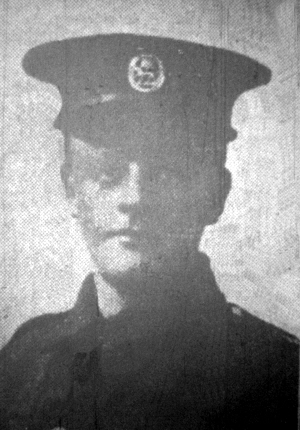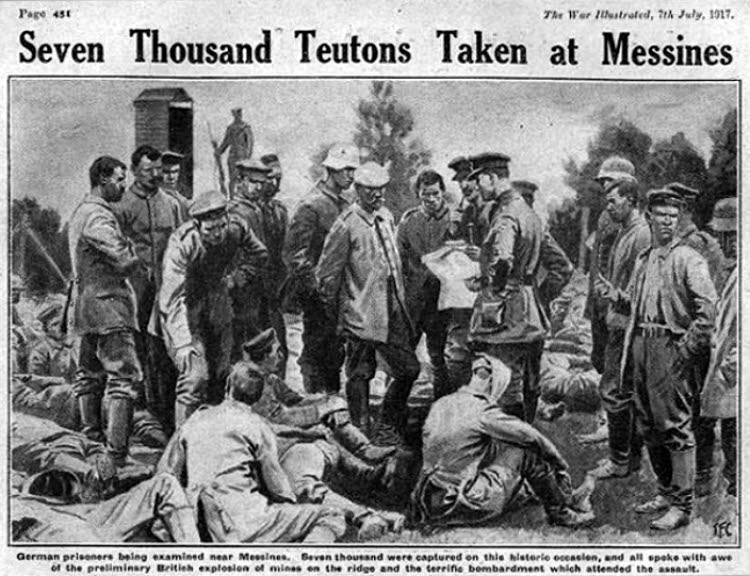
Horace Craven was born in Ossett on the 20th November 1897, and baptised at Ossett Holy Trinity Church on the 1st January 1898. He was the only son of Eli Craven and his wife Elizabeth (nee Lawford) who had married on 26 February 1893 at Gomersal St Mary’s Church. At the time of Horace’s birth in 1897, the Cravens were living at Ryecroft Street,Ossett.
In 1901, Horace, aged 3, is living with his parents, Eli and Elizabeth (later Eliza), at Ryecroft Street, Ossett. Eli is working as a power loom tuner and is now the father of two children, Horace and a daughter Laura, born in 1899.
By 1911, the growing Craven family are still living at 25, Ryecroft Street, Ossett and they now have another daughter, Marian, born in 1908. Horace is now employed as an errand boy and his father is still working as a power loom tuner in a local mill.
Horace Craven’s army service record has survived. Horace, of 25, Ryecroft Street, Ossett worked as a blanket weaver on enlistment. A bantam at only 5’ 2½” tall, weighing in at 108lbs and just 18 years and 185 days old when he enlisted on the 5th June 1916. He was mobilised on the 30th October 1916, remaining at home until the 28th January 1917 when he was posted to Base Depot, BEF France at Sunderland and then to 2/Bn, embarking from Folkestone and disembarking at Boulogne on the 29th January 1917 where he joined the 34th Infantry Base Depot at Etaples on the 30th January 1917, before joining his Battalion in the field on the 22nd February 1917.
The 8th (Service) Battalion of the York and Lancaster Regiment was formed at Pontefract in September 1914 as part of K3 and came under orders of 70th Brigade in 23rd Division. They moved to Frensham, and on to Aldershot in November 1914 then moved to Hythe in February 1915 and went on in May to Bordon. On the 27th of August 1915 they landed at Boulogne and on the 18th of October 1915 they transferred with Brigade to 8th Division. On the 17th of July 1916 they returned with Brigade to 23rd Division and in November 1917 they moved to Italy with 23rd Division.
The action at the Battle of Messines where Private Craven was killed is recorded in the War Diary of the 8th York & Lancaster Regiment, who were part of the 70th Brigade of the 23rd Division:
“June 1st: VANCOUVER CAMP (VLAMERTINGHE) – Football at TORONTO CAMP (near BRANDHOEK). 2nd A.P.O. YORKSHIRE REGT. – 4. 8th Y & L – 0. Camp shelled at night by a few 5.9’s. June 2nd: BIVOUAC – GENERAL SIR J.M. BABINGTON K.C.M.G. COMDR. 23rd Division, addressed all affairs on the subject of the forthcoming push. Camp shelled in afternoon & finally evacuated for bivouacs nearby, where the unit spent the night. The C.O.’S orderly was killed , also an artillery officer.
Sun June 3rd: Bivouacs moved to G.18.b.8.4 where we spent 3rd & 4th. Emergency route to front line was reconnoitred by companies.
June 4th: Day spent in interior economy, issuing fighting kit etc. At night we relieved the 13th D.L.I in the MOUNT SORRELL Sector, relief being completed with 3 killed and 6 wounded.
June 5th: TRENCHES – 4.30am. We had one Company in the front line, one in the MT SORRELL dugouts, one in STAFFORD STREET and one in RITZ STREET passed quietly.
June 6th: The 9th YORK & LANCASTER took over the line on the night of the 5th/6th. We took up assembly positions – B & C Coys MAPLE ST, A & D MT SORRELL in dugouts, Battalion H.Q. Same place as A & D. Another quiet day.
June 7th: We shared in the great victory by the 2nd Army. Zero hours 3.10am. The 9th Y & L took their objective in fine style, and at 6.50am we left their new line to attack the final objective (ZILLEBEKE map – IMAGE CRESCENT I.36.b.0.3 to I.30.d.5.1 approx). This we took with a strong-point about 50 yards in advance of the right flank, also the KNOLL, an eminence in NO MAN’S LAND in front of our centre. Our Officer casualties were CAPT. ANDREWS (KILLED), 2 LT HART (believed killed), 2 LT LUCAS (believed killed) and 2 LT’S ASTON, IMISON, VANSENDEN, LT. POPPLEWELL, CAPT. BELL, & 2 LT. BILLINGTON wounded. Estimated O.R. Casualties 300. No counter attacks after the position had once been consolidated.
8th June: We held our our gains, tho’ there was a terrific bombardment between 9 & 10.30pm. Our guns broke up an attempted counter-attack. Later we were relieved in the front line by the 9th YORK & LANCASTER REGIMENT, and the remnant of our unit took up quarters in MT. SORRELL duponts where we spent the night in rest. 9th June: On the night of the 9/10 we were relieved by the 1st N STAFFORD REGT. ( 72nd Bde. 4th Div. ) & returned by lorry to M Camp, near BUSSEBOOM.”
The attack effectively began on the 3rd June, when the preliminary bombardment intensified, and was kept up until 02:50 hours on 7th June. By this time, 100,000 men of the Second Army were lying in position waiting to attack. The weather was clear with a bright moon. The sudden silence spooked the Germans who started firing flares in an effort find an explanation. Twenty minutes of tension packed waiting culminated in a loud bang, followed seven seconds later by a continuous series of huge explosions which tore at the German front line and threw the watching British, 400 metres away, off their feet. The British rose from their trenches under cover of the renewed barrage of every gun available. Nine divisions of infantry advanced through the clouds of smoke and dust and within minutes, the whole of the German front line was in British hands.
Three hours later, the whole of the Messines Ridge was taken. No official figures were ever released regarding German casualties but there were 7,354 prisoners taken. There were 10,000 reported missing and over 6,000 known dead. British casualties numbered 16,000 of which about 30% were killed.
The success of the assault was in large part due to the explosion of 19 mines tunnelled under the German front line. Preparation work started in 1915 but it was only in the winter of 1916 that serious preparations took place. Twenty two mines were dug, some up to 2160 feet (658 metres) long and up to 125 feet (38 metres) deep. The explosion was heard by David Lloyd George, the British Prime Minister who was in his study in 10 Downing Street in London, there is even a report of an insomniac student hearing it in University College, Dublin.
The “Ossett Observer” 1 had this obituary for Horace Craven:
“A member of a well-known and respected Ossett family of cricketers – Private Horace Craven (19), of the York and Lancaster Regiment, only son of Mr. and Mrs. Eli Craven, of 25, Ryecroft-street, Ossett is numbered this week among the long list of local men who have sacrificed their lives in the war. Deceased was the only grandson of the late Mr. Robert Craven, whose sons have done so much in the furtherance of cricket locally. For twenty years or more, the deceased’s father was a playing member of the Chickenley club, and his son was following in the steps of his forebears, being a member of the cricket club associated with the Wesley-street, Wesleyan Sunday School.
At the end of last October the deceased went into the army, having previously being employed in the weaving department of Messrs. David Lee and Sons, Earlsheaton, and by the same post which brought the papers calling him to the colours, he received intimation that he had gained a scholarship, tenable at the Batley Technical School, entitling him to continue in a more advanced stage his studies in an industrial course of training. By the end of January, he had completed his military training and proceeded to the western front.
Writing home most regularly, it was apparent from the tone of recent letters that he was in a part of the line which received the constant attention of the enemy. In his last letter, dated Sunday 3rd June, he says ‘Fritz has begun shelling this district, and we have been sleeping out in the fields for three or four nights. We were in the huts the other afternoon, some of us asleep, others reading, when all at once we heard one of his shells coming. It seemed as though it was coming right for our hut. Well, we all cleared out as quick as lightning, and the shell burst just as I was going out of the doorway. It went clean through a hut and made a fine hole in the ground underneath. There was no-one in the hut at the time, or it would have been a bad job. Our hut was almost shaken over, and filled with dirt. We have had it rough while up the line this time, and now that we have come out, he will not leave us alone, apparently. I expect we shall be up the line again shortly. I don’t care how soon the whole thing is over, if it is ever going to be over. I am on ammunition guard tonight, so if Fritz drops a shell on it, it will be a bad job for some of us. How did you go on with the school feast? We are having warm weather during the day, but it turns cold at night.’
On Tuesday this week, the soldier’s parents received a letter from an officer, stating that Private Craven died of wounds on the 5th June. The officer conveyed the sympathy of the NCOs and the men.”
Private Horace Craven, aged 19 years, died on the 6th of June 1917 in the build up to the Battle of Messines. He was the only son of Eli and Eliza Craven. of 25, Rycroft St., Ossett, Yorkshire.
On 17th October 1917 the authorities returned Horace’s effects to his mother at Ryecroft Street Ossett; his effects comprised Disc, pipe, lighter, packet of tobacco, purse,2 tins with cigarettes, case, handkerchief, 2 pieces of pencil, pouch, match box cover, Ingersoll watch, metal chain, badge, 2 numerals.

Private Craven is buried at Plot I. Row A. Grave 38. in the Hop Store Cemetery 2, West-Vlaanderen, Belgium. Hop Store Cemetery is located 5.5 Kms west of Ieper town centre on the Casselsestraat, a road leading from the N308 Poperingseweg, connecting Ieper to Poperinge.
Although Vlamertinghe (now Vlamertinge) was just within range of the German artillery for the greater part of the First World War, units of Allied heavy artillery and field ambulances occasionally stationed their headquarters there. The Hop Store Cemetery, opened in May 1915, was on the safer side of the village but it remained a small cemetery because of its position between a hedge and the premises of the hop store itself. The site was low and marshy, particularly at the west end, and was drained by the Royal Engineers early in 1917. There are now 251 First World War burials within the cemetery, almost exclusively of 1915 and 1917.

Above: The Craven grave at St. John’s Methodist Chapel showing the memorial to Horace Craven, the son of Eli Craven. Picture courtesy of Lisa Jennings.
CWGC heastone photograph courtesy of Mark Smith
References:
1. “Ossett Observer”, June 16th 1917